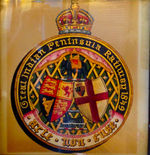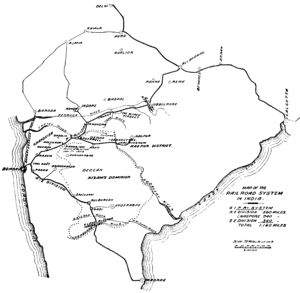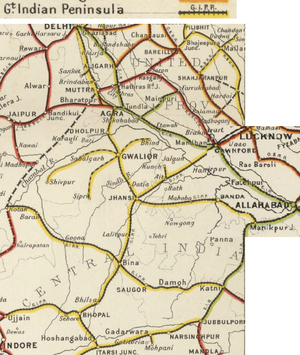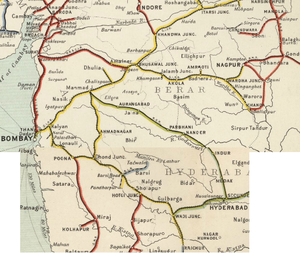Great Indian Peninsula Railway
| Great Indian Peninsula Railway | ||
|---|---|---|
 The Bombay-Poona Mail in full flight about 1910 | ||
| Line of route | ||
| Bombay to Raichur (SE Division} Bombay to Jubbulpore (NE Division)) Bhusawal to Delhi Bhusawal to Nagpur | ||
| Gauge / mileage | ||
| Broad gauge | 1562 miles (1905) | |
| Timeline | ||
| 1845 | Company formed | |
| 1853 | First section of line open to traffic | |
| 1871 | Through trains to Calcutta via Jubbulpore | |
| Dhond-Manmad State Railway absorbed | ||
| 1900 | Line acquired by State | |
| Key locations | ||
| Presidency | Bombay | |
| Stations | Kalyan, Poona, Hotgi, Wadi, Ahmadnagar, Akola, Chanda, Khandwa, Itarsi, Narsinghpur | |
| System agency | ||
| Worked by Great Indian Peninsula Railway | ||
| How to interpret this infobox | ||
| Great Indian Peninsula Railway | ||
|---|---|---|
 Great Indian Peninsula Railway device | ||
| System timeline | ||
| 1900 | Company re-formed to work State line | |
| 1925 | Government takes over working of system | |
| Constituent companies / lines | ||
| Great Indian Peninsula Railway | ||
| Agra-Delhi Chord Railway | ||
| Bhopal-Itarsi Railway | ||
| Bhopal-Ujjain Railway | ||
| Bina-Goona-Baran Railway | ||
| Gwalior Light Railway | ||
| 1900 | Indian Midland Railway | |
| Key locations | ||
| Headquarters | Bombay | |
| Workshops | see also GIPR Railway Workshops Parel (BG), Bhusawal, Harda, Igatpuri, Lonauli, Jhansi, Jubbulpore, Bhusawal | |
| Major Stations | Agra , Ahmadnagar, Akola, Amraoti, Banda, Bhopal, Bhusawal, Bombay , Cawnpore, Chanda, Delhi , Dholpur, Gwalior, Hotgi, Itarsi, Jhansi, Jubbulpore, Khandwa, Muttra, Nagpur, Narsinghpur, Poona, Raichur, Saugor, Wadi
See also heading Stations for major stations marked bold | |
| Successor system / organisation | ||
| 1951 | Central Railway (IR zone) | |
| System mileage | ||
| Broad gauge | 2988 miles (1905) 3363 miles (1943) | |
| 2' 0" NG | 183 miles (1905) 202 miles (1943) | |
| Associated auxiliary force | ||
| Great Indian Peninsula Railway Regiment | ||
| How to interpret this infobox | ||




|
See our interactive map of the North East Division locations and routes on Google Maps | |
|---|---|---|
Like most of the early railways in India, the Great Indian Peninsula Railway (GIPR) was a British company, registered in London, privately owned and financed, operating under licence and guarantee from the (British) Board of Control in India and the East India Company (EIC). The GIPR was India's and Asia's first railway.
The principal economic benefit of the GIPR was the opening up of the interior to Port and City of Bombay. The narrow coastal plain of India's west side is separated from the Deccan plateau by a mountain range, the Western Ghats which rises to 3,900 feet(1200m) and which has always restricted internal communication with the Arabian Sea.
The challenge was to create two lines through the Western Ghats, one to the north-east and one to the south-east, these were fully open by 1865 in time for cotton from the Deccan to be exported from Bombay to Manchester thus filling the trade gap created by the American Civil War. The lines were exteded to link Bombay to Calcutta and Madras by 1870.
History
- 1845. Registered as a company in 1845, with its head office in London, the ‘Great Indian Peninsula initially proposed a length of 1300 miles, to connect Bombay with the interior of the Indian peninsula and to a major port on the east coast. It was meant for the purpose of increasing the export of cotton, silk, opium, sugar and spices. The Announcement of company formation gave the listing of the ‘Committee of Management ‘ [1]. One of these being Robert Stephenson, London based Consulting Engineer, he remained in this capacity until 1859
- 1847. Stephenson reported preliminary findings to the directors, although he cannot have been in a position to provide more than general advice and a reviews of the material gathered by the surveys This concluded that the best method to climb 1800 feet over the Ghat mountains in just 15 miles was to use locomotives assisted by ropes worked by a stationary engine [2].
- 1847-48. The subsequent recession removed the financial incentive for railways in India but the GIPR scheme continued but only through the involvement of the ’East India Company’ which guaranteed a minimum of 5% dividend , however only a 35 mile route between Bombay and Kalyan was authorised [2].
- 1849. At the urging of the Governor, Lord Dalhousie, the East Indian Company(EIC) sanctioned the construction of a broad gauge(BG) railway eastward from Bombay and the ‘Great Indian Peninsula Railway Company ‘ was incorporated on August 1, 1849 by an act of the British Parliament. It had a share capital of 50,000 pounds. On August 17, 1849 it entered into a formal contract with the EIC for the construction and operation of an experimental line, 35 miles(56 km) long. The Court of Directors of the EIC appointed James John Berkley as Chief Resident Engineer and Charles Buchanan Ker and Robert W Graham as his assistants [3].
- 1850. Stephenson provided the directors with cost estimates and recommended James John Berkley as Chief Engineer to supervise the building of the line. The Court of Directors of the East India Company appointed James John Berkeley as Chief Resident Engineer with Charles Buchanan Ker and Robert W Graham as his assistants [3]
- 1850. A Tender was submitted for the first railway contract in Western India, from Bombay to Tanna, by William Frederick Faviell and Henry Fowler. The Tender was accepted by the ‘Great Indian Peninsula Railway Company’[4].
- 1851-53. Faviell and Fowler actively prosecuted the work, Fowler’s health failed after a few months’ exposure to the climate of India, and compelled his return to England. The execution of the contract then devolved entirely upon Faviell, and was completed to the satisfaction of the Company, the line being opened for traffic on the 16th April, 1853. That was the first line of railway opened for public traffic in India, and in its construction the first locomotive engine used in Asia was introduced on the 23rd February, 1852, for ballasting the line near Bombay [4].
- 1859. George Berkley succeeded Robert Stephenson as GIPR Consultant Engineer based in London. Previously Assistant and had been liaising with his brother James John Berkley, Chief Resident Engineer.
- 1859, GIPR was tasked with "the construction and working of the following lines, all of which terminate at Bombay, - viz. from Bombay, via Callian, to Jubbulpore, to meet the East Indian Railway Company's line from Allahabad, with branches to Mahim and Nagpore - 870 miles; and from Callian, via Poonah and Sholapore, to the opposite side of the river Kristna, to meet the line, via Bellary, from Madras - 366 miles - total, 1,236 miles. Capital 10,000,000ll. Rate of Interest Guaranteed - 5 per cent. on 8,000,000l. capital, and 4½ per cent. on 333,000l. debentures, the balance to be raised upon arrangements to be hereafter made." [5] [6].
Bombay - Callian - 33.5 miles(54km)
- 1850-51, the first sod was turned on 31 October 1850 and the first locomotive was used in construction on 22 December 1851
- 1853 April 16. A train, with 14 railway carriages and 400 guests, left Bombay bound for Thane, hauled by three locomotives: Sindh, Sultan, and Sahib. The 21 mile(34km) journey took an hour and fifteen minutes, it was the first section of the GIPR to be opened and the first railway for passenger service in India.
- 1853-54, the continuation of the line from Thane to Callian (later named Kalyan) was the first contact awarded to Messrs. Wythes and Jackson [7]. This section of the line involved a railway bridge over the Thane creek and the two-line Tannah Viaduct over the estuary and two tunnels. This viaduct was the first substantial railway bridge to be constructed in India and connected Bombay Island to the mainland and opened and on 1 May 1854.
North-East Line - Bombay via Callian and Thal Ghat to Jubbulpore - 615 miles(990km)
The GIPR Chief Engineer James John Berkley's proposal was to form a grand trunk communication by the north-eastern mainline between Bombay and Calcutta,
- 1857-61, Callian (later named Kalyan) to Kasara section constructed, a further 42 miles(68 km)[8] rising to an altitude of 948 feet(289m) above sea level at Kasara at the approach to the Thal Ghat. Opened in 1861.
- 1857 Aug, Messrs. Wythes and Jackson were awarded the contract for the Thal Ghat Railway Construction
- 1857-65. The Thal Ghat Railway was a major project to take the GIPR mainline across the Western Ghats towards Jubbulpore. The Kasara to Igatpuri section was 9.5 miles(15km) and within that distance the line had to rise to 1,918 feet(585m). The construction required 13 tunnels, 6 viaducts, including the Ehagaon Viaduct; cuttings; embankments; 15 bridges and culverts and the Reversing Station [9].
- c.1859-65, Messrs. Wythes and Jackson were awarded a further contact to construct a further section of the GIPR north-eastern line from Igatpuri at the end of the Thal Ghat, this was opened in stages reaching Chalisgaon in 1861, Jalgaon in 1863 and Bhusawal in 1865, a total of 191.24 miles(307km)[10].
- 1861-65, Igatpuri-Jalgaon-Bhusawal progressivly opened.
- 1863-67, GIPR Nagpur Branch from Bhusawal was built by Messrs. Lee, Watson and Ayton, Construction Contractors.
- 1865, with completion of Thal Ghat and the Taptee Viaduct near Bhusawal the mainline from Bombay reached Khandwa.
- 1868 July, Robert Maitland Brereton, GIPR Chief Engineer was given responsibility for completing the connection between Bhusawal and Jubbulpore which he completed many months ahead of schedule [11].
- 1868-70 the Khandwa to Itarsi section opened and with the Nerbudda Bridge completed the line reached Jubbulpore in 1870
- 1870 March 8. The Alfred Viaduct was inaugurated and named after the Duke of Edinburgh (Alfred Ernest Albert) who was visiting India and travelled by East Indian Railway from Calcutta. The Viceroy and the Governor of Bombay, Sir Fitzgerald Seymour had come from Bombay. With the opening of the GIPR North-Eastern Line the connection at Jubbulpore to the East Indian Railway (EIR) completed Dalhousie’s dream of a Bombay-Calcutta route.
South-East Line - Callian via Bhor Ghat and Poona to meet the Madras Railway - 409 miles(658km)
- 1856 May, the line was extended to the villages of Palasdhari(Padusdhurree) and to Khopoli(Campoolie) [12] at the approach to the Bhor Ghat. The
- 1856-63. The Bhore Ghat Railway Construction was a major engineering challenge to take the GIPR mainline across the Western Ghats towards Madras. The construction with GIPR Chief Engineer James John Berkley in charge involved an incline length of 15 miles(24km), 26 tunnels (totalling 2.25 miles(3.6km) in length), and 8 viaducts of masonry construction.
- 1858, the line from Khandala to Poona section was opened to traffic [12] , this section included the Dapoorie Viaduct
- 1858-63, during this period, the 21 km gap to Khandala was covered by palanquin, pony or cart through the village of Campoolie [12].
- 1863, Bhor Ghat completed the mainline was through to Poona(now called Pune) and Sholapore(Solapur).
- 1870, the Kisna Viaduct was opened and Raichur was reached in May 1871 [13] where it joined the Madras Railway to link to Madras [3].
GIPR Development from 1870
With the completion of the GIPR mainlines the three Presidency Capitals of Bombay, Madras and Calcutta were linked. The length of the route opened was then 1483 miles(2388 km) [3].
- “1870-71 Annual Report for Indian Railways for the GIPR “ gives:- ‘Broad Gauge (BG) Line opened 1870/71, 400 miles(644km), giving total Line length 1272 miles(2047km) and nil to be finished’. The Report also details of the ‘progress of the railway and the commercial summery’ - see separate pages for Report details.
- 1900 June 30, the assets of the GIPR were purchased by the Government of India(GoI) and merged with those of the Indian Midland Railway into a "new" GIPR, managed by the old company.
The GIPR continued to expand its network with the addition of 'Branch Lines', certain railways being ‘Absorbed’ and 'Working Agreements' on other railways - See separate page - GIPR Lines Owned and Worked
- 1918 “Administration Report on Indian Railways” [13] describes the ‘Great Indian Peninsula System’ with a total of 3441 miles(5489km). Comprising the ‘GIPR broad gauge’ (BG) line length of 2668 miles(4293km) and other Railways as detailed on separate ‘GIPR Lines‘ page
- 1925 Jan 1, the GoI took over direct control of the GIPR and transferred the Allahabad to Jubbulpore branch of the EIR to the GIPR.
- 1937 “History Of Indian Railways” gives the ‘Great Indian Peninsula System’ with a total of 3727 miles(5998km). Comprising the ‘GIPR broad gauge’(BG) line length of 3166 miles(5095km) and other Railways as detailed on separate ‘GIPR Lines’ page
- 1951. The GIPR combined with the Nizam's Guaranteed State Railway, the Dholpur State Railway and the Scindia State Railway to become Central Railway, a zone of Indian Railways.
GIPR Bridges and Constructions
The physical difficulties which had to be overcome are
The great physical difficulties which occur in the course of the GIPR are the mountains which separate Bombay from the Deccan, the ascent of which involves works of extraordinary magnitude and interest.
See separate page Great Indian Peninsula Railway Bridges and Constructions for details.
Stations
Bombay's Victoria Terminus was both the principal station and GIPR's HQ; designed by architect Frederick William Stevens. Victoria Terminus Construction commenced in 1878, it opened on Queen Victoria's 1887 Golden Jubilee and completed in 1888.

See separate pages for details of the Stations and Rail System into the following major Cities:-
Bombay Dock Railways
The GIPR had a collection of sidings spurring off to the docks in the east Bombay. There were numerous spurs to:
- Victoria Dock 1891
- Princes Dock 1888
- Carnac Basin
- Malet Basin
- Frere Basin
- Clerk Basin
Great Indian Peninsula Railway - Lines owned and worked
The GIPR operated an extensive network of railways of broad gauge(BG). In 1905 the route mileage was 1562 miles(2514km) and by 1918 was 2553 miles(4109km) divided into three sections ‘North East Division’, ‘South East Division’ and ‘Midland Division’ and their associated branches.
The GIPR also managed, worked and maintained a number of lines on behalf of other parties.
See seperate page Great Indian Peninsula Railway - Lines owned and worked
Later Development
Indian Railways (IR), Central Railway Zone (CR) was formed on 5 November 1951 by grouping several government-owned railways, including the ‘Great Indian Peninsula Railway’
Records
An on-line search of the India Office Records (IOR) records relating to this railway [14] gives 136 references. The most important being:-
- L /AG/46/12 “Records of the Great Indian Peninsula Railway Company; 1845-1926”
- L/AG/46/12A “Records of the Great Indian Peninsula Extension Railway Company; 1863-1869”
Personnel
Great Indian Peninsula Railway Personnel gives details of GIPR staff from several other sources:-
- Grace's Guide[15]
- Wikipedia and many other sources.
IOR Records The following India Office Records (IOR) are relevant :-
- L/AG/46/12/86 : GIPR Lists of appointments (officers 1849-1885; workmen 1852-1880)
- L/AG/46/12/88 : GIPR Contracts of employment (officers 1886-1925; workmen 1881-1925)
- Z/L/AG/46 : Index to UK Appointments to Indian Railways (1849-1925)
- Mss Eur D1184/14 : Letters to Arthur A West from G L Clowser Nov 1860-Nov
FIBIS Resources
External links
- Great Indian Peninsula Railway Wikipedia
- GIPR picture gallery Science & Society Picture Library.
- "Guaranteed Railways in India" Hansard 1803-2005 (accessed 04 December 2008)
- History (of Central Railway) Central Railway (Indian Railways). (now an archived site)
- Victoria Terminus, (GIPR HQ & station [Bombay]) Wikipedia (now known as Chhatrapati Shivaji Terminus)
- "Mumbai Multiplex : The line starts here" by Supriya Nair 4 January 2013. livemint.com "The ‘heritage wing’ of Chhatrapati Shivaji Terminus is a railway enthusiast’s dream"
- "Mumbai: Over 100 documents of Great Indian Peninsula Railway to be digitized" by Neha Kulkarni, July 12, 2016 The Indian Express.
Historical photographs online
- Hawkes collection of Indian Railway Photographs (Y3022S) Royal Commonwealth Society Library/ University of Cambridge Digital Library. The description states "An album containing albumen prints of various sizes by R. Phillips of Darjeeling, Samuel Bourne and others. The name of F.A. Hawkes, who was an engineer... appears frequently in it".
- Once inside the digital file, click on Contents for image titles. includes photographs whose titles include GIPR 1868-1869.
Historical books online
- The Cotton and Commerce of India: considered in relation to the interests of Great Britain; with remarks on Railway Communication in the Bombay Presidency by John Chapman, founder and late manager of the Great Indian Peninsula Railway Company 1851 Google Books. Contents-Railway Chapters page xix.
- Paper on the (GIPR) Thul Ghaut Railway incline by James John Berkley: GIPR Chief Engineer, Bombay, 1860.
- Reminicences of an old English Civil Engineer 1858 -1908 by Robert Maitland Brereton 1908 Archive.org. Includes Appendix: India page 49. Brereton's account of working on the GIPR 1857-1870. He became Chief Engineer.
References
- ↑ Grace's Guide " GIPR 1945 Company Registration Retrieved on 5 May 2020
- ↑ 2.0 2.1 Google Books “Robert Stephenson – The Eminent Engineer” edited by Michael R. Bailey; page 155-57 Retrieved on 5 May 2020
- ↑ 3.0 3.1 3.2 3.3 Grace's Gide "Great Indian Peninsula Railway which quotes from 'Morning Post' - Saturday 18 August 1849""; Retrieved on 5 May 2020
- ↑ 4.0 4.1 'Grace's Guide' - "William Frederick Faviell" Retrieved on 5 May 2020
- ↑ "Money Market and City Intelligence", The Times, Wednesday, 15 June 1859, #23333, 7a.
- ↑ H.M. Government “Statute Law Repeals: Nineteenth Report : Draft Statute Law (Repeals) Bill; April 2012"; pages 128-130 paragraphs 3.57 - 3.64 Retrieved on 3 Jul 2016
- ↑ Grace's Guide "Wythes and Jackson"; Retrieved 6 Jul 2016
- ↑ Graces Guide "Great Indian Peninsula Railway - 1865"; Retrieved 3 Jul 2016
- ↑ Google Books "Paper on the (GIPR) Thul Ghaut Railway" incline delivered to the Bombay Mechancs Institution in December 1860 by the GIPR Chief Engineer James John Berkley, page 20. Retrieved on 2 Jul 2016
- ↑ " Administration Report on the Railways in India – corrected up to 31st March 1918"; Superintendent of Government Printing, Calcutta; pages 64-68, pdf pages 73-77; Retrieved 6 Jun 2016
- ↑ The Statesman, New Delhi "The opening of the Mumbai to Kolkata railway by Michael Sandford, May 9 2016; Retrieved 3 Jul 2016
- ↑ 12.0 12.1 12.2 Wikipedia “Great Indian Peninsula Railway”; Retrieved 25 June 2016
- ↑ 13.0 13.1 " Administration Report on the Railways in India – corrected up to 31st March 1918"; Superintendent of Government Printing, Calcutta; pages 64-68, pdf pages 73-77; Retrieved 23 Jul 2016
- ↑ British Library “British Library Archives and Manuscripts Catalogue” - Search; Retrieved 22 Jan 2016
- ↑ “Grace’s Guide”; Retrieved 3 Jul 2016